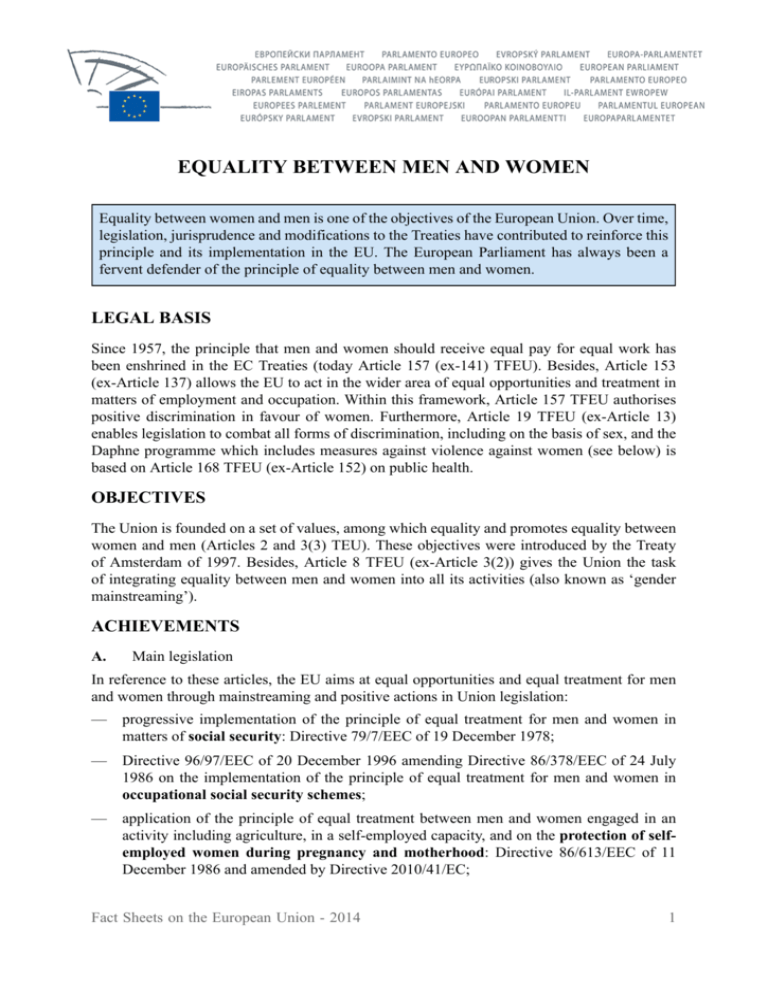Equality between men and women
advertisement

EQUALITY BETWEEN MEN AND WOMEN Equality between women and men is one of the objectives of the European Union. Over time, legislation, jurisprudence and modifications to the Treaties have contributed to reinforce this principle and its implementation in the EU. The European Parliament has always been a fervent defender of the principle of equality between men and women. LEGAL BASIS Since 1957, the principle that men and women should receive equal pay for equal work has been enshrined in the EC Treaties (today Article 157 (ex-141) TFEU). Besides, Article 153 (ex-Article 137) allows the EU to act in the wider area of equal opportunities and treatment in matters of employment and occupation. Within this framework, Article 157 TFEU authorises positive discrimination in favour of women. Furthermore, Article 19 TFEU (ex-Article 13) enables legislation to combat all forms of discrimination, including on the basis of sex, and the Daphne programme which includes measures against violence against women (see below) is based on Article 168 TFEU (ex-Article 152) on public health. OBJECTIVES The Union is founded on a set of values, among which equality and promotes equality between women and men (Articles 2 and 3(3) TEU). These objectives were introduced by the Treaty of Amsterdam of 1997. Besides, Article 8 TFEU (ex-Article 3(2)) gives the Union the task of integrating equality between men and women into all its activities (also known as ‘gender mainstreaming’). ACHIEVEMENTS A. Main legislation In reference to these articles, the EU aims at equal opportunities and equal treatment for men and women through mainstreaming and positive actions in Union legislation: — progressive implementation of the principle of equal treatment for men and women in matters of social security: Directive 79/7/EEC of 19 December 1978; — Directive 96/97/EEC of 20 December 1996 amending Directive 86/378/EEC of 24 July 1986 on the implementation of the principle of equal treatment for men and women in occupational social security schemes; — application of the principle of equal treatment between men and women engaged in an activity including agriculture, in a self-employed capacity, and on the protection of selfemployed women during pregnancy and motherhood: Directive 86/613/EEC of 11 December 1986 and amended by Directive 2010/41/EC; Fact Sheets on the European Union - 2014 1 — introduction of measures to improve the safety and health at work of pregnant workers and workers who have recently given birth or are breastfeeding: Directive 92/85/EEC of 19 October 1992; — Directive 2002/73/EC of 23 September 2002 amending Directive 76/207/EEC of 9 February 1976 on the implementation of the principle of equal treatment for men and women as regards access to employment, vocational training and promotion, and working conditions. This directive provides a Community definition of direct and indirect discrimination, harassment and sexual harassment. It also encourages employers to take preventive measures to combat sexual harassment, reinforces the sanctions for discrimination and provides for the setting up within the Member States of bodies responsible for promoting equal treatment between women and men; — Regulation (EC) No 806/2004 of 21 April 2004 which provides for gender mainstreaming in EU cooperation and development policy as a whole and the adoption of specific measures to improve the situation of women; — Directive 2004/113/EC of 13 December 2004 implementing the principle of equal treatment between women and men in the access to and supply of goods and services; and — in 2006, former legislative acts were included in a new Directive 2006/54/EC of 26 July 2006 on the implementation of the principle of equal opportunities and equal treatment of men and women in matters of employment and occupation (recast) and consequently repealed. Presently, the EP seeks a revision of the directive in relation to the equal pay provisions (see resolution of 24 May 2012)[1]. B. Progress in case-law of the European Court of Justice (ECJ) The ECJ has played an important role in the promotion of equality for men and women. The most notable judgments have been: — Defrenne II judgment of 8 April 1976 (Case 43/75): the Court recognised the direct effect of the principle of equal pay for men and women and ruled that that principle not only applied to the action of public authorities but also extended to all agreements which are intended to regulate paid labour collectively; — Bilka judgment of 13 May 1986 (Case 170/84): the Court ruled that a measure excluding part-time employees from an occupational pension scheme constituted ‘indirect discrimination’ and was therefore contrary to former Article 119 if it affected a far greater number of women than men, unless it could be shown that the exclusion was based on objectively justified factors unrelated to any discrimination on grounds of sex; — Barber judgment of 17 May 1990 (Case 262/88): the Court decided that all forms of occupational pension constituted pay for the purposes of Article 119 and the principle of equal treatment therefore applied to them. The Court ruled that men should be able to exercise their pension rights or survivor’s pension rights at the same age as their female colleagues; — Marschall judgment of 11 November 1997 (Case C-409/95): the Court declared that a national rule which, in a case where there were fewer women than men in a sector, required that priority be given to the promotion of female candidates (‘positive discrimination’) was not precluded by Community legislation, provided that that advantage were not automatic [1]See: European Parliament resolution of 24 May 2012 with recommendations to the Council on application of the principle of equal pay for male and female workers for equal work or work of equal value — Texts adopted, P7_TA(2012)0225. Fact Sheets on the European Union - 2014 2 and that male applicants were guaranteed consideration and not excluded a priori from applying; — C. Test Achats judgment of 1 March 2011 (Case C-236/09): the Court declared the invalidity of Article 5, paragraph 2, of Directive 2004/113/EC as being contrary to the principle of equal treatment between men and women in the access to and supply of goods and services. Consequently, for men and women, the same system of actuarial calculation has to be applied to determine premiums and benefits for the purposes of insurances. Last developments The EU’s most recent actions in the field of equality between men and women have been: 1. The financial framework a. The PROGRESS programme (2007-2013) The EU actions in the field of gender equality are funded under the Community programme for Employment and Social Solidarity (PROGRESS). Gender equality is one of the five fields of activity of this programme. A minimum of 12% of its almost EUR 658 million budget will be devoted to actions in this field over the period 2007-2013. b. The Daphne III programme (2007-2013) The Daphne programme is a Community programme aimed to prevent and combat violence against children, young people and women and to protect victims and groups at risk. It has a budget of EUR 116.85 million for the period 2007-2013. 2. The European Institute for Gender Equality (EIGE) The European Parliament and the Council established in December 2006 a European Institute for Gender Equality with the overall objective to contribute to and strengthen the promotion of gender equality, including gender mainstreaming in all Community and national policies. It also fights against discrimination based on sex and raises awareness on gender equality by providing technical assistance to the European institutions by collecting, analysing and disseminating data and methodological tools. The institute is based in Vilnius, Lithuania. 3. The European Commission’s network of women in decision-making in politics and the economy This network, launched in June 2008, provides a platform at EU level for exchange of good practices and successful strategies to improve gender balance in decision-making positions. 4. The Women’s Charter and the Strategy for equality between men and women (2010-2015) The Commission’s Women’s Charter of October 2010 and its Strategy for equality between men and women (2010-2015) adopted on 21 September 2010 provide for a comprehensive framework to promote gender equality in all EU policies and set out five key areas for action: — equality in the labour market and equal economic independence for women and men, namely through the Europe 2020 strategy; — equal pay for equal work and work of equal value by working with Member States to reduce significantly the gender pay gap over the next five years; — equality in decision-making through EU incentive measures; — dignity, integrity and an end to gender-based violence through a comprehensive policy framework; Fact Sheets on the European Union - 2014 3 — gender equality beyond the EU by pursuing the issue in external relations and with international organisations. The strategy is the follow-up of the roadmap for equality between women and men (2006-2010) which received large support of stakeholders due to its clear strategies and objectives. ROLE OF THE EUROPEAN PARLIAMENT The European Parliament has played a significant role in supporting equal opportunity policies, in particular through its Committee on Women’s Rights and Gender Equality (FEMM). Parliament’s action has been facilitated by the extension of the application of the codecision procedure, in particular regarding: — legislation to promote equality between men and women with regard to labour market opportunities and treatment at work (Article 153 TFEU); — legislation aimed at equal treatment of men and women in matters of employment and occupation (Article 157 TFEU). The Parliament is in favour of a longer and fully-paid maternity leave of 20 weeks, in a resolution voted in October 2010 but the revision of Directive 92/85/EEC is currently blocked in the Council; and — the adoption of measures in combating trafficking in women and children (Article 83(1) in connection with Article 82(2)), like for Directive 2011/36/EU. In addition, the Parliament contributes to the overall policy development in the area of gender equality through its own-initiative reports, and by drawing the attention of other institutions to specific problems, among which: — the increase of women in decision-making in politics[2] and in management boards by refusing a candidate for the Executive Board of the ECB[3] and as a co-legislator for the proposal for a directive on improving the gender balance among non-executive directors of companies listed on stock exchanges and related measures (COM (2012) 614) ; — the fight against violence against women[4] by preparing a legislative own-imitative report in 2013; — gender equality in times of crisis as highlighted by an interparliamentary conference at the occasion of International Women’s Day 2013 and the related resolution on the impact of the economic crisis on gender equality[5]; — gender equality in international relations, in particular regarding the developments since the so called Arab Spring in North Africa[6]. Through FEMM and its High Level Group on Gender Equality, the European Parliament has also developed dialogue and cooperation with national parliaments. An interparliamentary conference was held on 3 October 2012 to discuss what parliaments in the EU do for gender equality. Erika Schulze [2]See: European Parliament resolution of 13 March 2012 on women in political decision-making — quality and equality — Texts adopted, P7_TA(2012)0070. [3]See: European Parliament decision of 25 October 2012 on the Council recommendation for appointment of a Member of the Executive Board of the European Central Bank — Texts adopted, P7_TA(2012)0396. [4]See: European Parliament resolution of 5 April 2011 on priorities and outline of a new EU policy framework to fight violence against women — Texts adopted, P7_TA(2011)0127. [5]See: European Parliament resolution of 12 March 2013 on the impact of the economic crisis on gender equality and women’s rights — Texts adopted, P7_TA(2013)0073. [6]See: European Parliament resolution of 12 March 2013 on the situation of women in North Africa — Texts adopted, P7_TA(2013)0075. Fact Sheets on the European Union - 2014 4 07/2013 Fact Sheets on the European Union - 2014 5









